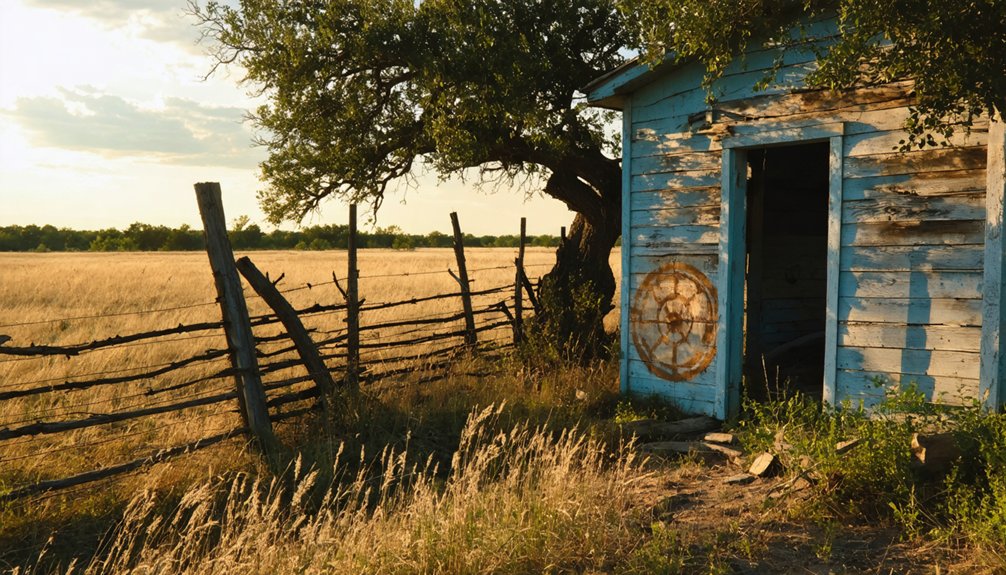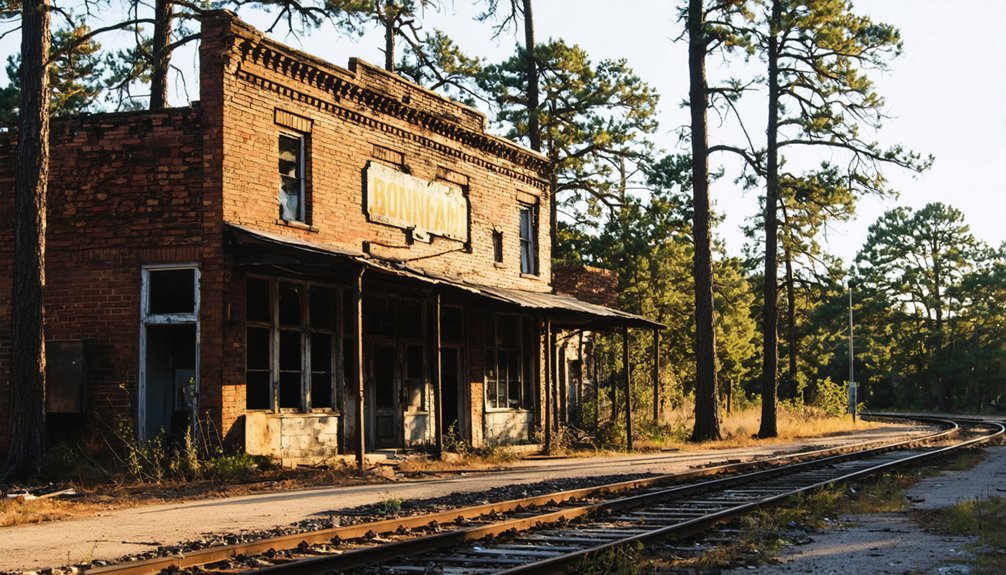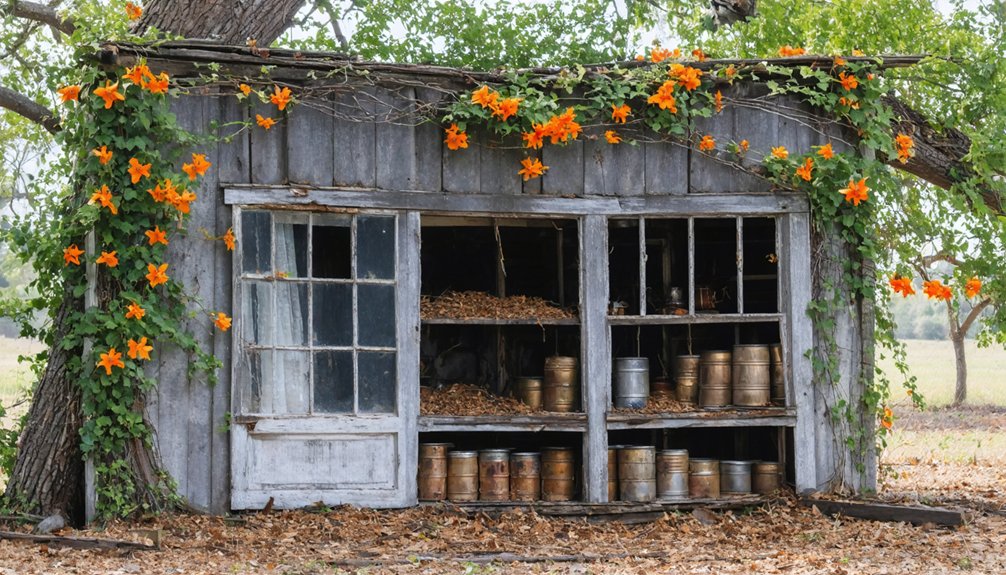You’ll find Warren’s ghostly remains along Texas’s Red River, where Abel Warren established a fortified trading post in the mid-1830s. As Fannin County’s first seat, the settlement boasted two blockhouses, a 15-foot log stockade, and the region’s thirteenth Masonic lodge. The bustling frontier hub featured Texas’s earliest courthouse and served as an essential commercial center between settlers and Native tribes. The site’s rich history holds countless tales of frontier diplomacy, fierce raids, and pioneer determination.
Key Takeaways
- Warren was established in the 1830s as a fortified trading post along Texas’s Red River by Abel Warren.
- The settlement featured a 15-foot log stockade with two blockhouses and served as Fannin County’s first seat in 1838.
- The town included Texas’ 13th Masonic lodge, the county’s first courthouse, and a school established in 1839.
- Warren’s Trading Post acted as a diplomatic hub between settlers and Native American tribes near the Red River.
- The settlement’s remains stand as a ghost town, preserving the legacy of Texas frontier life and early settler-Native relations.
The Birth of a Trading Post
In the mid-1830s, Abel Warren carved out an essential trading hub along Texas’s Red River, just south of Choctaw Bayou on the Fannin-Grayson county line.
You’d have found this Massachusetts-born entrepreneur testing various trading strategies, first in Fannin County before shifting operations closer to indigenous partnerships north of the Red River.
Warren’s vision materialized as a fortified sanctuary, complete with two blockhouses, a towering 15-foot log stockade, and rifle-equipped towers.
You could’ve spotted wagon trains rolling through its sturdy gates, bringing goods for trade while the fortress provided protection for settlers.
The post quickly became known as “Fort Warren” or “Fort Kitchen,” serving as a beacon of commerce and security in the untamed Texas frontier, where freedom and opportunity beckoned brave souls westward.
By spring of 1836, the trading post was completely abandoned as settlers began arriving in the area.
The trading post maintained a steady flow of business until trusted associate betrayed Warren by selling off the stock and disappearing while he was away getting married in Massachusetts.
Military Fortifications and Frontier Defense
If you’d visited Fort Warren in 1886, you’d have found yourself protected by an impressive fifteen-foot log stockade with two-story guardhouses at each corner, built from sturdy Bois d’Arc wood.
The fort’s strategic design allowed settler defense companies to control access through gates that regulated both stock and wagon trains, while maintaining clear sightlines from the corner towers.
Your safety at this frontier outpost would’ve depended on the vigilance of military escorts who protected trading parties and settlers from raids, working alongside volunteer defense companies that patrolled the shifting zones between white settlements and Indian territories. Life was particularly dangerous during full moon raids when Indian warriors would strike settlements and travelers. After the Mexican War, these protective measures became crucial as white settlement encroachment into the prairies left pioneers vulnerable to attacks.
Fort Design Features
Fort Warren’s impressive defensive fortifications showcased the resourcefulness of Texas frontier engineering, with its primary structure built from sturdy Bois d’Arc wood and surrounded by a towering 15-foot log stockade.
The fort’s defensive layout featured two-story guardhouses at each corner, giving you a commanding view of the surrounding territory and providing strategic firing positions against potential threats.
You’d have found the fort’s square or rectangular design practical and efficient, with gates large enough to welcome wagon trains and livestock.
This fort construction reflected the delicate balance between security and commerce – while the imposing stockade kept raiders at bay, the controlled entry points allowed for crucial trade with friendly tribes.
Similar to the earthwork defenses at Vicksburg, the fort was strategically positioned on high ground for maximum defensive advantage.
The corner towers guaranteed you’d spot any approach from miles away, whether friend or foe.
Trading post established in 1836, Fort Warren served as a vital commercial hub along the Red River near Choctaw Bayou.
Settler Protection Operations
While trading flourished at Abel Warren’s bustling outpost, the settlement’s military presence served an essential dual purpose: protecting settlers from raids while enabling commerce with friendly tribes.
Settler safety depended heavily on Fort Warren’s fifteen-foot log stockade and two-story defensive towers, which stood as proof of the untamed frontier spirit. The fort’s defenses proved vital as raiding war parties of up to 100 warriors would sometimes target vulnerable settlers and supply trains. Similar to operations at Camp Albert, the fort maintained vigilant protection against bandit raids along the border.
Key aspects of frontier defense at Warren included:
- Military escorts protecting civilian movements, including weddings and mail carriers
- Strategic positioning near the Red River to control access routes
- Coordination between civilian settlers and fort personnel for rapid response
- Adaptable defense tactics to counter evolving Native American raid patterns
You’d find the fort’s protective influence extending well beyond its stockade walls, safeguarding crucial supply lines and communication routes throughout Fannin County’s dangerous territory.
Volunteer Defense Companies
Beyond the stockade walls of Fort Warren lay a broader network of citizen defenders who took up arms to protect Texas’s wild frontier.
You’d find these volunteer companies forming as early as 1836, when the Milam Guards emerged in Houston as the first officially recognized unit under presidential command.
As threats from raiders and outlaws grew, frontier defense evolved to meet the challenge. Governor Pendleton Murrah established the Frontier Organization to strengthen Texas’s defense capabilities in 1863.
By 1874, you could spot mounted companies patrolling remote outposts, with local men serving in rotating shifts to guard their communities. Under state law, able-bodied citizens between 18 and 45 were required to serve in the militia.
The spirit of self-reliance ran deep – when nearly 4,000 men enrolled for frontier defense in 1864, they weren’t just defending territory; they were protecting their freedom and their way of life in the untamed Texas wilderness.
Growth as Fannin County’s First Seat
After being designated Fannin County’s first seat in 1838, Warren blossomed from a frontier trading post into a bustling center of civic life.
From humble trading post beginnings, Warren transformed into a vibrant civic center after becoming Fannin County’s first seat.
The settlement’s transformation into a hub of county governance brought rapid development, with townsfolk establishing key institutions that would shape early Texas history.
You’ll find Warren’s pioneering spirit reflected in these notable achievements:
- Construction of the county’s first courthouse in 1840, where justice was served on the frontier
- Establishment of Texas’ 13th Masonic lodge, bringing brotherhood to the wilderness
- Opening of the region’s first school in 1839, fostering education on the frontier
- Creation of essential mail routes and a post office under Roswell W. Lee’s direction
These developments marked Warren’s golden age as the seat of Fannin County’s early governance, though this prominence wouldn’t last.
Native American Relations and Conflicts

When you’d visit Warren’s trading post in 1837, you’d find a tense atmosphere as settlers and various Native American tribes, including Cherokees and their Twelve Associated Bands, attempted peaceful commerce despite growing conflicts over hunting grounds.
The increasing flow of settlers into Fannin County damaged traditional Native hunting territories, leading to retaliatory raids that often turned brutal, with documented attacks on cabins and travelers.
You can trace how these violent clashes continued until the 1839 Treaty of Bird’s Fort finally brought an uneasy peace between settlers and several tribes, including the Tehuacanas, Keechis, Wacos, and Caddoes.
Trading Post Diplomacy
During the turbulent years of early Texas settlement, Warren’s Trading Post emerged as an essential diplomatic hub between settlers and Native American tribes near the Red River bend. The post’s strategic location fostered important trader alliances and cultural exchange, serving as a gateway between two worlds.
You’d find these fascinating aspects of the post’s diplomatic role:
- Jesse Chisholm, a renowned frontier diplomat, frequently visited to facilitate negotiations.
- The post witnessed significant Native events, including the burial of Cherokee leader Sequoyah in 1843.
- Texas Congress recognized the post’s importance in their 1843 peace initiative.
- Local settlers built homes nearby, creating a protected space for cross-cultural commerce.
The trading post’s palisaded walls and armed towers didn’t just represent defense – they symbolized the delicate balance of power that enabled peaceful trade in these untamed borderlands.
Violent Frontier Clashes
Despite Warren’s earlier success as a diplomatic trading post, the settlement became embroiled in one of Texas’ most notorious frontier clashes – the 1871 Warren Wagon Train raid.
You’d find Henry Warren’s freight train under siege by 100 Native warriors led by Kiowa chiefs Satanta, Satank, and Big Tree near Salt Creek Crossing. The brutal attack left seven teamsters dead and sparked a turning point in frontier violence.
The raid intensified the region’s already volatile atmosphere, where Native resistance had grown fierce in response to settler expansion and diminishing bison herds.
You’ll see how this incident accelerated military responses, leading to unprecedented trials of Native leaders in U.S. courts.
Commerce and Community Life
As a bustling hub along the Red River, Warren carved out its identity in 1836 through Abel Warren’s establishment of a strategic trading post. Community commerce thrived around a fortified trading house where settlers and Native Americans exchanged furs, hides, and essential goods.
Warren’s trading post became a vital frontier marketplace where settlers and natives forged economic bonds through the exchange of goods.
Social networks formed through the town’s taverns, lodges, and general stores, creating a vibrant frontier community.
- The town’s 15-foot log stockade protected merchants like Daniel Montague and William Henderson, who operated thriving general stores.
- Joseph Sowell’s tavern served as both a commercial hub and gathering spot for locals.
- Samuel Westbrook’s blacksmith services supported the settlement’s growing trade.
- The 13th Masonic Lodge established strong social bonds among prominent citizens, making Warren a cornerstone of regional development.
The Shift of Power to Bonham

While Warren’s stockaded trading post had once dominated Fannin County’s affairs, the political winds shifted dramatically in 1843 when Bois D’Arc claimed the coveted county seat designation.
You’ll find that shifting power dynamics played out swiftly as settlers and commerce gravitated eastward toward Bois D’Arc Creek, leaving Warren’s influence to wane.
The following year, Bois D’Arc’s renaming to Bonham – honoring fallen Alamo defender James Butler Bonham – cemented the new seat’s prominence in county politics.
The transformation wasn’t just symbolic; it marked a decisive shift from frontier defense to civil governance.
As Warren’s military post stood abandoned and its buildings crumbled, Bonham flourished with new roads, courthouses, and the steady flow of settlers seeking opportunities in this promising hub of regional authority.
Legacy of a Lost Settlement
The vanished settlement of Warren leaves behind more than just empty fields along the Red River – it carries the echoes of Texas’ earliest frontier days.
Though this ghost town has disappeared without a trace, its historical significance lives on through the stories of brave settlers who shaped early Texas history.
- You’ll find Warren’s spirit in the tales of its thirteenth Masonic lodge, where notable frontier figures like E.H. Tarrant gathered in 1840.
- Its legacy survives in records of the trading post that once connected settlers with essential supplies along the dangerous frontier.
- The settlement’s role in early Indian relations and trade helped establish patterns of development along the Red River.
- Warren’s brief reign as Fannin County’s first seat of power set the foundation for the region’s governmental structure before Bonham’s rise.
Frequently Asked Questions
What Was the Average Population of Warren During Its Peak Years?
You’ll find Warren’s demographics reached their highest around 883 residents during the 1890 peak, when population trends were driven by the bustling lumber industry that’d transformed this free-spirited Texas town.
How Many Buildings Were Constructed in Warren Before Its Abandonment?
You’d find roughly 15-20 structures featuring frontier building styles, including the stockade fort, courthouse, cabins, and towers – their architectural significance reflecting early Texas settlers’ resourceful determination.
What Happened to the Original Residents After Warren Was Abandoned?
You’ll find relocation stories of Warren’s folks heading mainly to Bonham, the new county seat, while others scattered to Red River trading posts or nearby counties, maintaining descendant connections through generations.
Were There Any Epidemics or Natural Disasters That Contributed to Warren’s Decline?
You won’t find epidemic impact or disaster aftermath in Warren’s story – historical records show its decline came purely from losing the county seat and being bypassed by the railroad.
Did Any Famous Historical Artifacts Get Recovered From the Warren Site?
While over 10,000 artifacts were found at nearby Washington-on-the-Brazos, you won’t find famous artifacts specifically from Warren. The site’s historical significance relies more on regional archaeological recoveries.
References
- https://www.tshaonline.org/handbook/entries/old-warren-tx
- https://www.redriverhistorian.com/post/warren-once-was
- https://www.fannincountyhistory.org/fort-warren
- https://en.wikipedia.org/wiki/List_of_ghost_towns_in_Texas
- https://www.tshaonline.org/handbook/entries/warrens-bend-tx
- https://redriverhistorian.wordpress.com/category/ghost-towns/
- https://www.youtube.com/watch?v=uq-D7kiFKiU
- https://www.okhistory.org/publications/enc/entry?entry=WA027
- https://www.fannincountymuseum.org/sketch88
- http://www.granburydepot.org/z/biog/TradingPosts.htm



